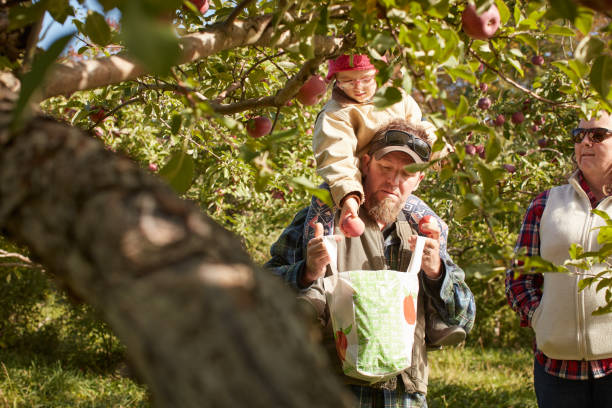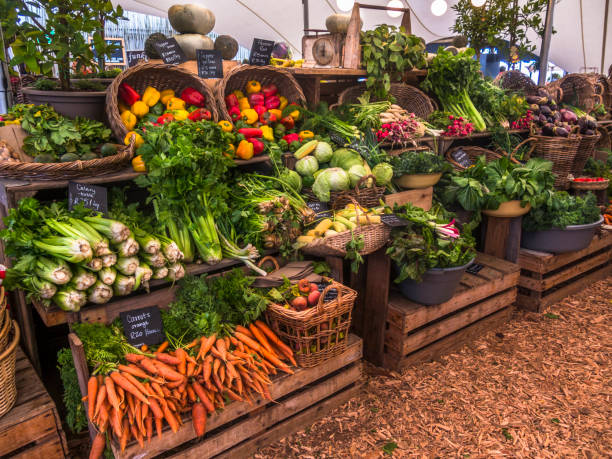GMOs and Fall Harvest Season
Summer is making way for fall again, and for many people, that means visions of apple picking, hayrides, pumpkin patches, fall festivals, and of course, drinking lots and lots of pumpkin spice lattes! But it’s also a very important time of the year for many farmers: harvest season. While you won’t see most GMOs in the produce section of your local grocery store, examples of GMO fruits and vegetables harvested in the fall include apples, eggplants, squash, zucchini, and potatoes.
And as our thoughts turn to these foods, and food in general, we know people still have questions about GMOs, even though they’ve been on the market for 25 years. So, for #Harvest2020, we’ve put together a resource that answers questions about your food from the perspective of the farmer. Find out why farmers grow GMOs and why they think they are a great tool for their family farm below:
Why Do Farmers Use GMOs?
 Farmers choose what seeds to grow based on what is best for their farms, market demand and local growing environments. Farmers also look for ways to grow crops using resources more efficiently and with less impact on the environment.
Farmers choose what seeds to grow based on what is best for their farms, market demand and local growing environments. Farmers also look for ways to grow crops using resources more efficiently and with less impact on the environment.
More than 17 million farmers around the world, the majority in developing countries, choose to plant genetically modified seeds due to their advantages, which can include reducing the impact of agriculture on their environment, reducing costs via more targeted pesticide use and reducing yield loss or crop damage from weeds, diseases and insects, as well as from extreme weather conditions such as drought. Learn more about why farmers grow GMO crops on this resources page at the GMO Answers website.
Seeing is Believing: Modern Technology Delivers Change
They say a picture is worth 1,000 words. A video of AD Alvarez’s farm on social media has attracted more than 50,000 views—and counting. It uses the incredible power of images to convey a simple and important truth about the safety, effectiveness, and advantage of GMO corn. The video is from his farm in the Philippines, where he grows mainly yellow corn on about 10 hectares. One of his goals is to show how technology can improve the lives of poor farmers. Learn more about this farmer and why he chooses to plant GMOs in this blog post from the Global Farmer Network.
How GMOs Fit into the Farm Toolbox
Illinois farmer and GMO Answers volunteer expert Katie Pratt writes, "Sustainability is a great goal, but to sustain is to maintain, and maintenance is not our focus on the farm. Continuous improvement, i.e. leaving things better than we received them, is.
To do that we fill our farm toolbox with people, equipment, technology, and science to give us options to use less of our natural resources and care for them, all the while raising a high-quality crop for use far beyond the typical applications to food, fuel, and fiber. Farming is our life choice, but it is also our business. On the farm, our tools range from the typical tractor and seeds to tablets and satellites."
Why I advocate for GMO crops in Africa
Jean Claude Habimana, son of a Rwandan farmer, writes in a blog post for the Cornell Alliance for Science: If South Africa, Sudan, America, China, India, Brazil, Paraguay, Argentina and Australia and many other countries have used GM crops to secure their food supply and generate billions of dollars from exports, and no study has ever scientifically shown or been published that describes any risk from consuming GMOs, what are the African countries waiting for? Please hear the evidence from scientists, see the tears and agony of our farmers and then make the right decision that benefits our farmers.
What I’m Grateful For This Harvest: The Safety And Sustainability Of GMOs
A guest post by American farmer Debbie Borg on the GMO Answers Medium page begins, GMOs (genetically modified organism) play an important role in the conservation efforts on my farm because they provide my husband and me the ability to grow more with less- in a way that is safer and healthier than we could have imagined when we started farming in 1978. Read the rest of the article here.
GMO Corn Doubled My Production
CropLife International talked to Filipino farmer Edwin Paraluman about how biotech crops transformed his life and about agriculture in general in the Philippines. He noted, "I had stopped planting corn on my farm because of damage from the corn borer. But when I saw biotech insect-resistant corn and learned how the crop could resist the corn borer and increase my harvest, I was very happy to accept it. The farmers have seen that this technology is good for us and it boosts our economy."
There's Nothing Wrong with A 21st-Century Farm
 With agriculture being one of our oldest pursuits, and most of the U.S. population being one or more generations away from the day-to-day life of farming, it’s easy to see why some romanticized views of farming persist still today. Some think most farms still operate much the same way they did in the 1950s. Some believe that farms should go back to operating that way.
With agriculture being one of our oldest pursuits, and most of the U.S. population being one or more generations away from the day-to-day life of farming, it’s easy to see why some romanticized views of farming persist still today. Some think most farms still operate much the same way they did in the 1950s. Some believe that farms should go back to operating that way.
Well, time and technology march on for all industries — even agriculture. Although the work ethic, pride, and focus on the family hasn’t changed much, the tools we farmers use have changed a lot over the generations. Genetically modified crops (GMOs) also are at our disposal if we need to use them. Learn more about a typical 21st-century American farm in this guest blog post from GMO Answers volunteer expert and farmer Brian Scott.
Why GMOs? A Global Farmer Perspective
The Global Farmer Network convened a farm roundtable, hosted by the International Maize and Wheat Improvement Center (CIMMYT) and moderated by scientist Luis Ventura, to listen to what farmers around the world had to say about GMOs, agriculture, and their work. This article features four Global Farmer Network farmers making the case for biotech crops and biotechnology innovation: Gina Gutierrez, Mexico; Gaytri Devi, India; Patience Koku, Nigeria; Yara de Geus, Brazil. Find out what they had to say!
GM Crops: The Future for Global Farmers
In a world beset by so many disasters, both naturally occurring and man-made, subsistence farming is far from a secure way of life. With potential economic ruin and starvation lurking just one failed harvest away for so many, we as a global society have a moral duty to help alleviate this burden. Genetically modified (GM) crops may raise eyebrows among some who view it as tampering with nature, but have we not done that in so many other walks of life? Technology has already achieved so many wonderful things that it would be foolish to let ideology trump pragmatism by refusing to let it do so again in agriculture. Read the rest of this guest column at the Cornell Alliance for Science website.
So, as you’re starting to enjoy those pumpkin spice lattes, freshly made homemade apple pies, and crisp socially-distanced fall walks, remember to think about the farmers who grow your food and decorative gourds. Harvest 2020 is here! To learn more about GMOs, from farmer decisions to environmental benefits to health and safety, please feel free to explore the rest of the GMO Answers website.
